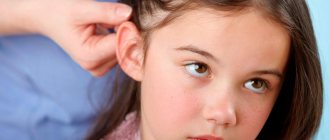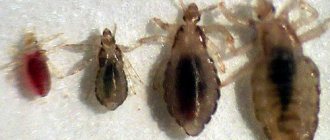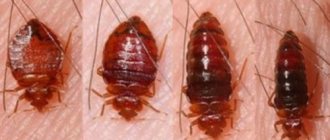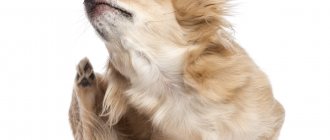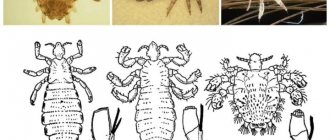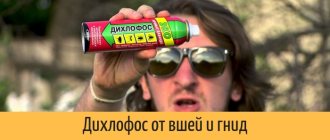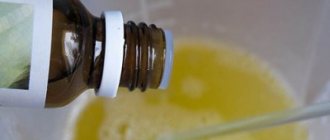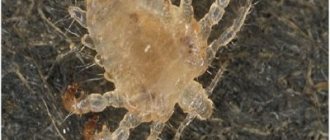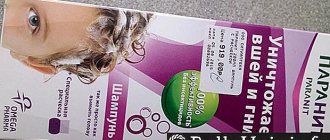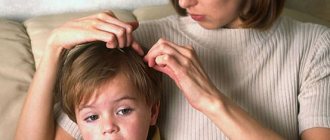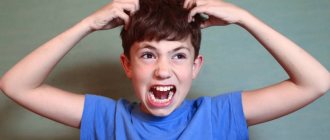Why are lice and nits dangerous during pregnancy?
The presence of insects in the head or on the body can, in addition to purely uncomfortable sensations, cause a number of health problems, which is especially contraindicated during the period of bearing a child:
- Stress, disturbance in the functioning of the nervous system . Future mothers are impressionable people. Due to constantly fluctuating hormonal levels, emotional swings are normal for them. Any unpleasant event, including the discovery of parasites on a comb or pubic area, will cause a storm of negative emotions. In addition, the constant itching that accompanies lice will not allow the pregnant woman to sleep and live peacefully, thereby irritating the woman even more. Naturally, any negative experiences are not good for the developing embryo.
- Lice are carriers of typhus, Volyn fever and relapsing fever . Any of these diseases is very dangerous, especially during pregnancy.
- The feeling of constant itching causes one desire - to scratch the place where it occurs . This procedure is not always carried out with clean hands. Therefore, when small wounds appear due to friction of nails on the skin when scratching, the risk of inflammation in their place increases due to the penetration of pathogenic microorganisms from dirty hands directly into microtraumas of the skin.
Types of parasites
In nature, there are several types of lice that parasitize humans:
- The head louse settles, lives and reproduces exclusively on the scalp. Currently it is found much more often than its “relatives”.
- Body (linen) louse lives on clothing or bedding. For her, a person, or rather his blood, is a source of nutrition, but she cannot live on him.
- The pubic louse lives where coarse hair grows on the body: pubic area, eyelashes, mustache.
ATTENTION! You can become infected with lice in public transport or public places (hairdressers, hospitals, wardrobes), from a child of kindergarten or school age, in a store while trying on headpieces or accessories, or through sexual contact (pubic lice). The main condition for infection is close contact with the carrier of the disease.
Where do lice come from?
There is a common belief that lice are a disease of disadvantaged people. Unfortunately, in our time the situation has changed. Everyone suffers from pediculosis - both janitors and oligarchs, however, the latter have more opportunities to quickly get rid of insects. A pregnant woman should not worry too much about this disease, because it can and should be fought.
Methods of infection
The survival of many insect species is due to their explosive reproductive capacity. Huge hordes of locusts destroy crops in entire regions; bedbugs that appear in one apartment spread throughout the entire house after a couple of weeks. Lice keep up with them in terms of reproduction speed, which allows their population to live well in large cities, jumping from one carrier to another.
Read more about the types of lice, how they reproduce, and the incubation period on our website.
Pregnant women are no exception. Parasites can appear from various sources, and those from which it is impossible to protect yourself. Possible routes of transmission of pediculosis:
- public transport. Try to avoid trams and buses during rush hour.
A crowded vehicle is the perfect place to share lice with others. Take precautions - do not take off your hat, tuck your hair under your coat, and when you come home, take your outerwear and hat out to the balcony; - clinics and hospitals. Here you can catch lice, first of all, in the wardrobe.
You can protect your clothes that will come into contact with the collars of other people's coats by spraying a few drops of tea tree oil on them; - older children attending school or kindergarten.
If you already have children who attend kindergarten or school, you are at risk. Very often, it is preschool institutions that become the place from which insects begin to actively spread throughout the area. Always pay attention to the head of your firstborn - if he starts scratching it, or a rash appears on his neck, the child may have lice and urgently need to carry out preventive lice treatment.
Read more about the causes of lice infection on our website.
ATTENTION! In public places, such as a theatre, museum, clinic, antenatal clinic, try to secure clothes before putting them in the wardrobe. This can be done in two ways:
- the first is to turn coats and jackets inside out and store them in this form (it is more difficult for insects to gain a foothold on the smooth surface of the lining fabric);
- the second is to put things in a bag, tie it, and then transfer it to the wardrobe.
Symptoms
A person infected with pediculosis does not always immediately detect uninvited guests. The louse that gets into the hair must still multiply. While she is alone, the bites are situational in nature, they can be confused with ordinary itching. To accurately determine why your head itches, you need to know exactly what symptoms of the disease indicate the onset of infection:
- Redness behind the ears. The primary symptom of pediculosis.
Usually by this time the louse has already been on the head for several weeks, and its numerous offspring have already hatched. This is the first generation of lice, they are not too numerous yet. By constantly biting the epidermis, they cause a local allergic reaction. - Red rash on the skin. This phenomenon can be observed when the second and third generations of lice hatch.
They become crowded on the scalp and extend beyond it. The red dots of the rash are nothing more than marks from the bites of insects that make a late meal at night. - Constant itching of the scalp. At this stage it is very difficult to remove lice. Most likely, a whole population of insects thrives on the head, which are always hungry and endlessly bother the wearer.
Symptoms of lice
The development of any disease, including head lice, is accompanied by a number of symptoms and signs.
Head
It is quite easy to recognize the presence of insects in the head:
- The sensation of itching in the hair occurs as a result of the parasite releasing a special enzyme into the scalp, which has an irritating effect on humans. The more lice there are, the stronger the desire to scratch your head.
- The presence of a rash from insect bites , the location of which is most often the area behind the ears or at the border of the hairline and scalp.
- The main sign of the presence of parasites in the hair is the presence of tiny (about 1.5 mm) translucent nits on them , which can easily be confused with dandruff, but unlike it, you cannot shake off the eggs: their removal requires some effort, because they are attached to the hairs with the help of a special sticky secretion secreted by the female.
Pubic
Diagnosing the presence of a parasite in a “delicate” area is not difficult.
- Pubic louse and nits are easy to recognize visually.
- A bite of the human epithelium is also accompanied by the release of a substance that causes an itching sensation. Constant itching of the intimate area is one of the main signs of the disease.
- The presence of bluish spots in the area of the bites , developing as a result of hemorrhages at the puncture site.
- Dark spots on underwear , which often appear in women, are the product of parasites.
Believykh
Identical symptoms and signs accompany the appearance of clothes insects: severe itching on the body, the appearance of microtraumas or bluish bruises at the site of bites, constant irritability, inability to sleep at night. It is also possible to develop an allergic rash, which may be accompanied by attacks of nausea, vomiting, fever, and headaches.
IMPORTANT! Pediculosis is a rapidly progressing disease that requires urgent measures to combat it. The choice of the means with which the treatment will be carried out should be treated with extreme caution, since a high dose of chemicals in the composition can harm the health of the pregnant child.
Is it possible to remove lice quickly and safely in one day?
The answer to this question is ambiguous: you can answer in the affirmative if a potent insecticide is used to treat lice. But its use can have a very negative impact on the development and health of the embryo. Pregnant women should give preference to those drugs that are made on a natural basis. Unfortunately, parasites are extremely resistant to many substances, so it is realistic that several treatments may be needed.
REFERENCE! When using any purchased product for head lice, you must strictly follow the instructions indicated in the annotation. It is unacceptable to change the dosage of a substance or increase the time period of exposure of the drug to the body.
What means cannot be used to fight the disease?
It is worth paying attention to the fact that not all remedies are suitable for the treatment of head lice in pregnant women. It is strictly forbidden to use:
- dust soap - it can cause breathing spasms;
- kerosene - the consequences of using this product are unpredictable - from fainting to vapor poisoning;
- all industrially produced drugs. They contain toxic substances.
The best remedy for pediculosis allowed for a pregnant woman is a frequent anti-pediculosis comb.
Regular combing of your hair will first reduce the lice population, and then completely get rid of these parasites. Read our article about how to properly comb out lice and nits.
Pediculosis during pregnancy is a nuisance that can and should be gotten rid of. It is worth remembering that sooner or later the pregnancy will end in childbirth, and when admitted to the maternity hospital, not only the mother’s tests are checked, but also her hair for the presence of lice.
Sequence of actions in the fight against pediculosis
Pediculosis in a pregnant woman can be cured quickly and without harm to health. Recommendations for controlling parasites:
- A visit to the doctor who is managing the pregnancy. The specialist will select funds, depending on individual characteristics, prescribe a diet, vitamins to improve immunity, antihistamines and antiseptics, if necessary.
- General cleaning of the apartment. Bed linen and clothing require washing and ironing with hot steam.
- Treat all family members against lice. This is a prerequisite for effective treatment. A pregnant woman is treated with means that are safe for her. The rest can use special emulsions, sprays and shampoos against lice. The procedures are carried out in one day.
- Old combs, hair ties, headbands, etc. throw them away, buy new ones.
By following all the rules, you can get rid of parasites quickly enough.
Why is lice dangerous during pregnancy?
There is a common belief that lice carry diseases. Actually this is not true. The irritation, itching and prolonged treatment can be unpleasant, but dermatologists do not consider lice a health threatening condition. Sometimes scratching bites leads to a secondary skin infection, but this happens quite rarely. Thus, lice themselves are not dangerous during pregnancy. This concerns both the health of a pregnant woman and the well-being of her unborn child.
According to dermatologists, the main danger lies in incorrect methods of treating head lice. The use of caustic or toxic substances to control lice can actually harm the health of the mother and fetus. This point must be taken into account when choosing a method of controlling parasites.
How to remove underwear and pubic parasites
Expectant mothers are susceptible to infection not only by head parasites; pubic lice are a common and widespread occurrence among pregnant women.
How to poison lice in the groin, because they cause psychological discomfort to its owner no less than head lice?
The drastic method of destroying pubic bloodsuckers will be shaving off the hair in the armpits and groin. A pregnant woman should notify her gynecologist about the problem, because there is a risk of having concomitant sexually transmitted diseases.
It will take several months to remove body hair. Wounds left as a result of parasite bites are treated with peroxide and zinc ointment. It is safe to use and has a drying property.
Linen lice live in clothing and the seams of bedding. But, in order to get food, they crawl onto the human body and drink blood.
You can get rid of lice mechanically by washing all your clothes in very hot water. For cotton fabrics, it is recommended to use boiling. Then each item must be ironed.
The remaining bite marks on the pregnant woman’s body should be treated with peroxide and Bepanten and Levomekol ointments applied.
What is more effective against head lice: chemicals or traditional methods?
In the fight against pediculosis in pregnant women, both pharmaceutical drugs and folk remedies are used. Each method has advantages and disadvantages.
Pharmacy insecticides:
- Expensive;
- Have a toxic effect on a woman’s weakened body;
- Penetrate through the placental barrier, reaching the fetus;
- Contain toxic substances that cause anatomical changes in fetal formation;
- They have a pungent odor and irritate damaged tissues of the scalp.
There are also advantages to using it - the ability to quickly get rid of nits and parasites.
Folk ways to get rid of pediculosis:
- Economical;
- They have a minimum of contraindications;
- Non-toxic.
A significant drawback is low efficiency. In order to completely get rid of the disease, treatment is carried out at least 5 – 7 times with an interval of 1 day.
Attention! Medicines for head lice should not be used by pregnant women if they contain the following chemical compounds:
- Permitrin;
- Cyclommethicone;
- Phenothrin.
Even a reduced dosage leads to severe intoxication of the pregnant woman.
There are a number of drugs with minimal toxicity. They do not penetrate the systemic bloodstream, but have a detrimental effect on lice.
How to safely get rid of lice during pregnancy?
The main problem with treating head lice during pregnancy is the possible health risks posed by chemicals. Therefore, many women choose a mechanical method of eliminating lice or resort to home recipes. The main disadvantage of these methods is low efficiency. It is indeed possible to get rid of lice with their help, but this will require a lot of time and effort.
An effective and safe alternative is the anti-pediculosis drug “Paranite Sensitive”. its mechanism of action is fundamentally different from how insecticide-based drugs work. "Paranit Sensitive" does not have a neurotoxic effect. Instead, it attacks the lice physically.
Lice breathe through microscopic holes (spiracles) located on the sides of their bodies. Through these same holes they remove excess fluid from the body after drinking blood. Having high surface tension, water does not penetrate into the spiracles from the outside. Paranit Sensitive contains a patented complex based on the substance dimethicone. This is a silicone oil that can penetrate the respiratory system of lice and nits and clog it. Violation of breathing and water balance leads to the death of insects and their eggs.
Dimethicone is actively used in cosmetics to moisturize the skin. Therefore, Paranit Sensitive belongs to the category of low-hazard compounds and can be used to treat young children and pregnant women. Another advantage of the entire Paranit line of products is that lice do not develop resistance to them. Accordingly, processing can be carried out as many times as necessary.
Low toxicity drugs
When choosing a lice remedy for pregnant women, carefully read the instructions. In most cases, in the abstract, contraindications for use are lactation and pregnancy.
Less toxic are medicines for head lice that contain the component d-95. The oil concentrate penetrates the respiratory system of the parasites, causing death.
To treat short hair, one sachet is enough; long curls will require several doses. The oil concentrate is applied along the entire length of dry curls, then combed with a comb and left as an effect for 45-50 minutes. At the end of the procedure, the hair is thoroughly washed and rinsed.
A drug with low toxicity is Nyuda. Dimethicone-based spray is safe for children over one year of age and during pregnancy. Silicone oil penetrates the respiratory system of parasites, displaces oxygen, clogs the lungs and causes death from suffocation.
Spray the spray evenly over the entire length of the hair, leave for 40 - 60 minutes and rinse thoroughly.
The drug for lice is considered safe, but the label states: pregnant women should not use the drug. Choosing between two evils, doctors prescribe anti-lice spray to pregnant women with severe head lice infestation.
Lice shampoos are widely used among pharmaceutical products. Not every anti-pediculosis shampoo is approved for pregnant women.
Paranit shampoo is effective and safe. A product based on clearol, an oil concentrate of mineral origin, approved for use by pregnant women, lactating women and small children.
The exposure time of the medicine is 10 minutes. Next, the head is washed and dead individuals are removed.
Pedilin
The line of anti-lice products for pregnant women includes shampoo and emulsion. The drugs are approved for use in the treatment of children and expectant mothers.
In case of severe infection, the products are used in tandem: the emulsion is immediately used (aged), then shampoo. The final stage is combing out the dead individuals with a special comb.
Knicks
The lice remedy for pregnant women contains Canadian fir balsam. The product is included in a group of medications that contain permethrin - you should consult your doctor before using the cream.
Delacet
An economical remedy for lice during pregnancy: it is enough for 4-7 applications. It differs in the content of acetic acid, which greatly facilitates the process of getting rid of dead individuals.
The list of contraindications for use is empty; the possibility of local allergies cannot be ruled out.
Pediculicide D-95
To a large extent, these criteria are met by D-95, an oil-based preparation that is applied with the included comb strictly to dry hair and scalp. Next, leave it for 45-50 minutes, after which you wash your hair as usual and carefully comb each strand from head to tip. After 7 days, the procedure is repeated.
On average, it takes 2 sachets for shoulder-length hair. The price of a package of 10 sachets of 10 ml each is 129 rubles.
Spray Nuda
Aerosol composition based on silicone oil. When treating hair, biphasic dimethicone penetrates the respiratory system of the parasite, causing it to suffocate. And this applies to both adults and eggs.
Available in 50 ml bottles, which is enough to treat medium-length hair. The spray is applied to dry hair and combed through with the included comb. Treat hair until it is completely wet, then leave for 40-45 minutes. Next, the hair is combed again from the very base, carefully removing dead nits and lice, after which the hair is washed as usual.
Price 1 bottle 564 rub.
How to get rid of lice during pregnancy?
All methods of getting rid of head lice can be divided into three main groups. Let's consider how effective and safe each method is during pregnancy:
- • Mechanical removal of parasites. The combing method has been used to combat head lice for a very long time. Its main advantage is absolute safety, which is very important during pregnancy. The essence of the technique is to comb out adult lice and nits using a fine-toothed comb. To make it easier for the comb to slide through your hair, you can first apply a little balm or conditioner to it. The main disadvantage of this method is that treatment requires a lot of time and effort.
- • Pharmaceutical products for lice. Today you can find many anti-pediculosis drugs in pharmacies. Each of them has its own mechanism of action and its own side effects. The instructions for pediculicides should indicate whether they can be used during pregnancy or breastfeeding. Even if the drug is approved for use, it is better to consult your doctor first. The main disadvantage of pharmaceutical products based on insecticides is that lice develop resistance to them, and the effectiveness of treatment decreases
Doctors recommend treatment in three stages. The first is the use of a mechanical method of eliminating lice. Combing must be repeated every three days until lice and nits are completely gone. If you cannot get rid of parasites using this method, you should try using home remedies - essential oils, vinegar, herbal decoctions, etc. If this method does not help, you can use pharmaceutical preparations.
The best ointments
- Cream Nyx (Germany). The active components included in the drug are selected in such a way that the effect occurs only on parasitic insects. The remaining components, including those of natural origin (Canadian fir balsam), “soften the blow” of the insecticide on the body of a pregnant woman. Insect death occurs within 10 minutes due to asphyxia. You can buy the product for an average of 200 to 500 rubles, depending on the region.
- Medifox is an emulsion that is applied directly to the hair and rubbed over it like a cream. The main components - permethrin (in a small dose) and natural castor oil - affect the periphery of the parasites, paralyzing them. The average price is 120 – 200 rubles.
- Nittifor. The main component - permethrin - is presented in a small dose, only 1%. But this does not reduce the effectiveness of the drug: by acting on the membrane of the nerve endings of parasites, it causes their paralysis and then death. You can buy the product without a prescription, paying on average 170 – 280 rubles for 1 bottle.
The best anti-lice shampoos for pregnant women - TOP 3
- Nit Free (Argentina). The shampoo in this series is made on the basis of natural ingredients (for example, essential oil of mint, tea tree, eucalyptus, coconut), which do not pose a threat to the baby in the womb. In addition to its anti-pediculosis effect, the product prevents tangling of hair, makes it easier to comb without weighing down the strands. Its use is an excellent prevention of re-infection. Requires systematic treatment (course 10–14 days). Approximate price – from 650 rubles for 118 ml.
- Veda – 2 (Russia). This shampoo, due to its low toxicity (0.5% permethrin), does not harm the body of the expectant mother and the embryo. In addition, the result will be maintained for 2 to 6 weeks after use. The death of insects occurs due to their paralysis. To purchase the drug you will need to pay about 150 - 200 rubles per 100 ml .
- Pedilin (Slovenia). The active substance is malathion, which successfully penetrates the chitin of parasites and causes their self-poisoning. The average price is 250 – 300 rubles per 100 ml bottle.
Traditional methods
Various traditional methods are used to treat pediculosis. Essential oils are very popular.
Doctors do not recommend using ethers while pregnant. A strong odor can provoke the development of toxicosis, and a concentrated composition can cause an allergic reaction.
Expectant mothers are recommended to use safe and effective means to combat parasites, for example:
- Vinegar solution;
- Cranberry juice;
- Onion mask;
- Vegetable oil;
- Tea tree oil;
- Laundry and tar soap.
You should understand: folk recipes will not be as effective as they should be in one use. It will take several days to actively fight and after each procedure to mechanically remove nits and dead individuals.
Vinegar as the mildest method
Lice in pregnant women can be treated with vinegar. It can be called the mildest application option. The usual 9% liquid is dissolved 1 to 1 with water. Next, moisten the cotton towel and wrap it, and wrap a bandage over the makeshift cap. It takes 1-2 hours for the solution to act on adults and significantly damage the adhesive part of the egg cocoon.
For cleaning you need to use 9% food vinegar.
All are washed off with regular shampoo, and then you can remove them manually, as described earlier. If necessary, the operation is repeated after a week.
You cannot delay treatment, so you need to start fighting immediately after identifying the problem. Since the life and health of the future human being is at stake, we recommend that you contact a parasitologist and get advice from him on the appropriate remedy.
Cranberry juice
A safe and at the same time effective remedy that allows you to cure head lice during pregnancy.
Cranberries contain many acids of organic origin:
- Lemon;
- Benzoin;
- Cinchona.
These components quickly destroy the adhesive substance with which the louse attaches the eggs to the hair shaft.
Apply freshly squeezed juice or mashed berries to your hair and leave for 7 to 10 minutes. Then the head is washed and nits are removed mechanically.
Onion mask and vegetable oil
The vegetable contains oils that have a nerve-paralytic effect on parasites.
- chop 2 - 3 medium-sized onions in a meat grinder,
- apply the prepared mixture to your hair,
- leave for 10 minutes.
Then wash your hair and remove any paralyzed insects.
Vegetable oil is recognized as the safest method of getting rid of lice during pregnancy.
Apply the oil concentrate to the scalp, wrap your hair with a towel and leave for 20 minutes.
The oil causes suffocation for parasites; nits easily peel off from the rod, greatly facilitating the process of mechanical removal.
Tea tree oil
The vapors contained in the concentrate have a suffocating effect on individuals. The parasites are temporarily immobilized, making it easy to remove insects from the hair.
Important point! Don't throw bloodsuckers in the trash. Soon they will wake up and go in search of a new owner.
Flush the specimens down the toilet or burn them.
Laundry and tar soap
To get rid of lice using soap, you need to wash your hair for 5-7 days with tar or laundry detergent.
After each wash, nits and lice are removed with a fine comb.
The method using natural soap is safe; the active substances have a detrimental effect on bloodsuckers and dissolve the adhesive substance with which the nit is attached.
Ivy budra
Pour 1.3 tablespoons of the plant into a glass of vinegar and infuse this mixture for a week.
2. Rub into the scalp and rinse after 50 minutes.
After the first use of this recipe, all parasites will die.
Ivy budra is famous for its beneficial properties.
In folk medicine, the above-ground part of the plant is used to prepare various remedies.
Herbal decoctions
To prepare the decoction, you need to pour one tablespoon of the raw material with a glass of boiling water and let it brew for 20 minutes. The decoction is applied to the curls and kept for 20-30 minutes.
Then everything is simply washed off with running water. The following plants are suitable for controlling parasites:
- honeysuckle;
- tansy;
- sagebrush;
- mint;
- wild rosemary herb.
Safe treatment of pediculosis with folk remedies
During pregnancy or while breastfeeding, many people refuse medications, resorting to traditional medicine if necessary. You can remove lice from a pregnant woman using the following means:
- herbal infusions (mint, wormwood, wild rosemary, juniper, honeysuckle);
- essential oils (tea tree, geranium, lavender);
- vinegar is diluted with water, applied to the hair, then the parasites are combed out (it negatively affects lice and weakens the attachment of nits to the hair);
- cranberry juice;
- vegetable oil;
- a mask of chopped onions (not suitable for all pregnant women and nursing mothers due to the strong odor that lingers on the hair for a long time);
- pomegranate juice with mint.
In the beginning, when there are still few parasites, you can deal with them by combing your hair daily with a special fine-toothed comb. But as insects spread, more effective control methods have to be added.
Combing out lice
At the pharmacy you can buy a special metal comb with long thin teeth for combing out parasites. Mechanical removal technique:
- The hair is carefully examined and the number of lice and nits is determined. Parasites prefer to settle on the back of the head, in the area behind the ears.
- The hair is divided into four equal strands from the forehead to the neck.
- Three strands are pinned, one is combed with a comb from roots to ends. Combed out parasites should be collected on a white cloth. The person performing the procedure must put a cap on his head and hide his hair. It is advisable to work in a disposable medical gown.
- The treated strand is put aside and the comb is washed in hot water. Start combing out the next strands.
Combing is carried out over a bathtub or a white sheet. Parasites should not be allowed to fall on the floor or upholstered furniture. Several procedures will be required to completely remove lice. You can brush every day until the symptoms of head lice disappear.
Regular combs are not suitable for combing. The frequency of the teeth and their rigidity are not sufficient to remove parasite eggs. Only specialized metal combs are needed. There are combs that kill parasites with an electric discharge.
Will painting with ammonia paint help?
Painting helps get rid of head lice, but it is important to choose the right paint. It must contain ammonia or hydrogen peroxide.
It is known: during pregnancy, cutting and dyeing curls is prohibited. The coloring pigment penetrates the placental barrier and has a negative effect on the development of the fetus.
This fact is not scientifically proven. But still, for safety reasons, doctors do not recommend dyeing your hair during pregnancy and breastfeeding.
If you are not a fan of superstitions, you can quickly remove lice by bleaching your hair. In order to change the image and treat head lice, coloring is a radical way out of the situation.
INTRODUCTION
Medicines should be used with caution in women of childbearing age. Topical agents have less systemic exposure. Thus, they are considered safer than oral or parenteral drugs and less embryonic and fetotoxic. However, their safety must be assessed with caution, since information on them is limited (in pregnant women). This article presents human and animal studies to determine optimal recommendations for the use of anti-lice and anti-scabies during pregnancy.
INTRODUCTION
What is already known? Topical agents are generally considered safer than oral or parenteral medications during pregnancy. However, topical medications can be embryonic and fetotoxic. The old FDA fetal risk categories (A, B, C, D, X) do not accurately reflect the risk of using medications during pregnancy. Scabies is an intensely itchy dermatosis caused by the mite Sarcoptes scabiei var. hominis.[1] Highly contagious with the pathognomonic symptom of “itchy burrows”, night itching and erythematous papules. [2] There are many medications available for treatment, such as Permethrin, Ivermectin, Lindane, Benzyl Benzoate, Malathion, Crotamiton and sulfur preparations. Pediculosis of the scalp, also known as head lice, is caused by Pediculus humanus capitis.[3] Itching of the scalp is the main symptom, although there may be no complaints.[4] Treatment begins if there are live lice or viable nits. There are three conditions for treatment: wet combing, topical and parenteral anti-pediculosis agents.[5] Despite the numerous drugs available, they must be used with caution in pregnant women, as some drugs are toxic and can cause significant harm to the fetus. This article combines human and animal studies and provides recommendations for the safe use of topical anti-scab and anti-lice therapy in pregnant women. Table 1 presents risk categories for the effects of foods and drugs on pregnancy. Table 2 provides a summary of recommendations for the use of topical anti-scabies and anti-lice products during pregnancy.
Table 1. Categories of risk of influence of food and drugs on pregnancy.
| Risk categories | Definition |
| A | Controlled studies found no risk: Complied studies found no increased risk of fetal abnormalities in pregnant women |
| IN | There is no proven risk to the human body: studies that meet all the requirements have not been conducted in humans; No risk has been identified for animals. |
| WITH | The risk cannot be excluded: studies on humans are insufficient, and studies on animals are either absent or a risk to the fetus has been identified. |
| D | There is evidence of adverse effects on the fetus: There is evidence of risk to the fetus, but the benefit of use in a pregnant woman may outweigh the risk. |
| X | Contraindicated in pregnancy: there is evidence of a risk to the fetus from studies or observations in humans and animals. |
| N | The medicine has not been studied |
Table 2. Recommendations for topical anti-scabies and anti-pediculosis agents.
| A DRUG | FDA categories | Recommendations |
| Benzylbenzoate | WITH | Cleared for use, not available in the US |
| Camphor (Camphora) | WITH | Authorized for use |
| Corticosteroids | WITH | Use low or moderate potency agents, use minimal active corticosteroids |
| Crotamitonum | WITH | Allowed to be used as a backup after Permethrin |
| Ivermectin | C | Avoid use |
| Lindane | WITH | Avoid use |
| Malathionum | IN | Allowed to be used as a backup after Permethrin |
| Menthol | N | Safe to use |
| Permethrin (Permethrinum) | IN | Safe to use |
| Sulfur preparations (precipitated sulfur) | WITH | Safe in small doses |
| Spinosad | IN | Safe in small doses |
In December 2014, the FDA published a pregnancy and nursing drug labeling rule that eliminated the categories. Instead of categories, it is necessary to provide information about the risk of using the drug for pregnant women and the fetus on the instructions for medications. The old labeling has been criticized as overly simplistic and not fully reflecting the risks of using products during pregnancy and lactation. The new requirements came into force on June 30, 2015. All new drug instructions will use the new labeling format, while drugs approved after June 30, 2001 will gradually transition to it. Because the drugs discussed in this article have not all moved to the new labeling requirements, we present the FDA's pregnancy risk categories, along with a description of available research and recommendations for their use [Table 1]
LOCAL ANTISCABES AND ANTIPEDICULOSIS MEDICINES
Benzylbenzoate (Category C, not available in the US)
Benzyl benzoate was banned in the United States because its metabolite, benzyl alcohol, has been associated with fatal neonatal toxicity (Gasping syndrome, with encephalopathy, metabolic acidosis, bone marrow underdevelopment, and multiple organ failure). [6] However, cases of toxicity have only occurred when benzyl alcohol was used to flush central venous catheters. Products containing benzyl alcohol can still be found on sale in the United States. Following topical use of benzyl benzoate in animals or humans, there is no evidence of toxicity other than local skin irritation.[7] A study was conducted in Thailand in which 444 pregnant women took part in topical use of 25% benzyl benzoate in the second and third trimester. No birth defects were identified in the children. [8] Topical use of benzyl benzoate is likely safe [9, 10].
Camphor (Category C)
When applied topically, Camphor has a cooling and analgesic effect, therefore it is effective for itchy skin diseases. In animal studies, there is no evidence of embryotoxic or teratogenic effects, even at high doses. [11,12] But when taken orally, Camphor can cross the placental barrier, and can potentially lead to fetal death or respiratory failure in newborns. [13] As part of the Collaborative Perinatal Project, 168 women used Camphor topically throughout pregnancy. As a result, no signs of congenital malformations of the fetus were detected. [14] Additionally, no birth defects were found in 763 women who used Camphor periodically during pregnancy. [14] To date, there are no reports of adverse fetal outcomes resulting from the use of the drug during pregnancy. [15] Thus, the use of Camphor topically is allowed. [9,10,16,17]
Corticosteroids (category C)
A 2015 Cochrane analysis assessed five cohorts and nine case-control studies and concluded that, regardless of activity class, topical corticosteroids are safe during pregnancy. They do not increase the risk of fetal malformations, congenital anomalies, or adverse perinatal outcomes such as preterm birth, stillbirth, low Apgar scores, or fetal death. [18] However, an association has been found between the use of highly potent topical corticosteroids and low birth weight, especially if the cumulative dose is very high during pregnancy. [18] It is important to note that the effects of topical corticosteroids on the fetus vary depending on the anatomical location of application. Low degree of penetration: feet (0.14%), ankle (0.42%), palms (0.83%), forearm (1%) back (1.7%). High degree: scalp (3.5%), face, neck, armpits (3.6%), forehead (6%), eyelids (42%), and groin area (42%) [19] Thus , low- to moderate-potency topical corticosteroids are safe during pregnancy. And potent ones should be used short-term due to the possible risk of fetal growth retardation.
Crotamitonum (category C)
1% of the topical dose is thought to have systemic effects.[22] No studies have been conducted on humans or animals. There are no reports of adverse outcomes in pregnant women using Crotamiton.[23] Due to the lack of data on its safety, Crotamiton should not be used as a first-line drug. However, the drug is considered safe for use during pregnancy. [10,24,25,26]
Ivermectin (category C)
In animal studies, at doses that caused toxicosis in pregnant women, fetal malformations were identified: cleft palate, exencephaly, drumstick fingers. [27] A three-year Liberian study found that Ivermectin was very common among pregnant women. Two hundred women and three children born to women using Ivermectin did not demonstrate a risk of birth defects (compared to the control group).[28] In 1993, 110 pregnant women were identified in Cameroon who had used Ivermectin without caution. After the study, there was no increase in the incidence of abortions, stillbirths or congenital malformations of the fetus. In a second study of 97 pregnant women treated with Ivermectin compared with women who did not take the drug, there was no significant difference in fetal outcomes. [29]
Lindane (category C)
Lindane is banned in many countries but is available in the United States. Studies of the drug in double concentration on rats showed: impaired motor activity, increased mortality, decreased weight of offspring. [32,33] A threefold increase in concentration led to stillbirth of offspring. [32,33] However, no malformations were identified in these studies. [32,33,34,35] In Michigan, a study was conducted on 1,417 newborns whose mothers used topical Lindane in the first trimester of pregnancy. There was no increase in the number of defects, such as cardiovascular anomalies, cleft lip and palate, spina bifida, and polydactyly. But seven cases of hypospadias were identified (three of which were expected). [17] Several cases of stillborn infants, neural tube defects, and mental retardation have been identified. [36] Due to potential toxicity, Lindane should be avoided during pregnancy. [10,26,37]
Malathionum Karbofos (category B)
Animal studies have found no evidence of teratogenicity or gross fetal abnormalities [38]. A group of 22,465 children born to mothers exposed to Malathion aerosols in the first trimester of pregnancy showed no increased risk of birth defects. [39] A case-control study of 7,450 women exposed to Karbofos in 1981–1982 in San Francisco did not find an increased risk of birth defects. [40] In addition, studies of mothers who had malathion detected in their urine found no differences in fetal birth weight, head circumference, or neurodevelopment compared with the control group. [41,42] Although Malathion is probably safe for use during pregnancy, it should be used after other safer alternatives have failed (eg, mechanical lice debridement or permethrin). [10,43,44,45,46] When using Malathion, it is recommended to use aqueous solutions (instead of alcohol) and not exceed the recommended dose.
Menthol (category N)
Menthol is a widely available drug. Lotions containing menthol are used as local pain relievers. Even when the dose was exceeded by 106 times, no teratogenic effects were observed in the offspring. [15] Although there are no human studies, there is no evidence of negative effects during pregnancy. [25] Topical use of menthol lotions is safe. [10,16,47]
Permethrin (Permethrinum) (category B)
It is believed that 2% of the topical dose has a systemic effect. [7] Animal studies have not demonstrated harm to the fetus. [48] In a prospective study of 113 pregnant women who used Permethrin shampoo (31 in the first trimester), there was no evidence of embryotoxicity. [49] Another study of 196 pregnant women used 4% Permethrin and also found no harm to the fetus. [8] Permethrin is considered the first-line drug for topical treatment of parasitic infections. Permethrin is safe for use during pregnancy. [26,30,37,50]
Precipitated sulfur preparations (category C)
Although sulfur preparations are not first-line medications, they are used to treat initial and recurrent cases of scabies. [51] It is believed that 1% of the topical dose has systemic effects. [52] There is little information about its safe use during pregnancy. Due to low permeability into the body as a whole, and the absence of reports of adverse results, it is believed that sulfur preparations are not dangerous to the fetus. After using first-line medications such as permethrin, limited topical use of sulfur preparations is considered safe. [10,53,54]
Spinosad (category B)
Animal studies with the use of the drug Spinosad "per os" did not reveal teratogenic effects. When applied topically, Spinosad cannot be detected in the blood after 10 minutes. [55] Long-term studies for carcinogenesis in animals have been negative. [55] Genotoxicity tests showed no evidence of mutagenic or clastogenic potential. [55] Spinosad is poorly absorbed through the skin and is rapidly metabolized and eliminated from the body. [56] Although the suspension contains an undetermined amount of benzyl alcohol, it remains unclear how much of the drug is needed to cause embryotoxicity and fetotoxicity. [55] There are no studies in humans, but given that the drug has low systemic exposure and there is no known toxicity in animals, the drug is safe in small doses [Table 2]. [17.56]
CONCLUSION
Although there are many topical medications used to treat scabies and head lice during pregnancy, to date, there is more evidence regarding the safety of permethrin for use during pregnancy.
Prohibited substances
When pediculosis (lice) is diagnosed during pregnancy, you need to know what can be used to treat the patient and what absolutely cannot be done. All products containing insecticides are prohibited. They contain quite aggressive components that primarily affect the nervous system of insects. The substance is absorbed into the human blood, and if for an adult such a dose is too small to cause harm, then for the fetus it can be critical.
The following drugs are strictly taboo:
- Aerosols, sprays and emulsions that contain permethrin. The insecticide negatively affects the development of the fetus, as well as weakened female immunity.
- Products based on isopropyl myristate and cyclomethicone are less toxic to the body. The way these substances affect insects is different from permethrin, but they are also harmful to expectant mothers.
- Kerosene. It is strictly forbidden to use this liquid, since not only vapor poisoning is possible, including loss of consciousness and other unpredictable reactions of the body.
Pregnant women should use those pediculicides that are recommended for children.
VIDEO: Lice and scabies – School of Dr. Komarovsky
How to cure pediculosis during pregnancy?
Dealing with lice is not an easy task for pregnant women. You cannot use products from the pharmacy - most ready-made products contain toxic poisons that can enter the bloodstream through the scalp. Various products based on essential oils can also have a negative effect on the expectant mother. Pregnant women are very sensitive to odors; individual intolerance to some of them may develop, turning into toxicosis.
So, if a pregnant woman has lice, what should she do? - After all, this condition is dangerous, especially in the second trimester, so it is better not to experiment even with relatively harmless natural-based products. But folk remedies, with enough patience, can help remove lice. There are the following recipes for such products that are safe for expectant mothers:
- cranberry juice. The berries must be mashed into a paste and rubbed into the hair roots. After completing the procedure, the head is thoroughly washed.
- Apple vinegar. This is a fairly harmless product with only one drawback - an unpleasant odor. But it is outweighed by one advantage that is very pleasant for women - after using vinegar, the hair shines, like after an expensive balm.
- NitFree. A series of products that does not contain toxins and has a natural, hypoallergenic composition. The only drug that is allowed to be used against lice during pregnancy after consultation with a therapist.
Read more about how else you can remove lice and nits from pregnant women here.
So as not to get infected
While carrying a child, a woman is especially vulnerable and susceptible to various infections. A weakened body directs all its forces to preserve the fetus, which is why chronic diseases worsen.
You can protect yourself from lice infestation by following preventive measures. Not allowed:
- Wearing other people's hair accessories;
- Use of combs;
- Trying on hats and headdresses;
- Staying in places with large crowds of people with loose hair;
- Visiting the pool without a rubber cap.
If there are children in the house, especially schoolchildren, regularly examine the scalp for lice. The child will not immediately suspect that someone is in his hair. It happens that a mother discovers with horror that the disease is advanced, lice are swarming and have produced an uncountable number of nits.
If one of the family members is infected, everyone is treated. To consolidate the result, the procedure is repeated after 10 days.
Prevention of head lice
To prevent lice infestation, just follow a few simple rules:
- 1. Explain to your child that lice are transmitted through close head-to-head contact.
- 2. Despite the fact that the likelihood of contracting lice through combs and hats is very low, it is better if the child does not use other people’s hygiene items.
- 3. It is better to wear long hair in girls in a tight ponytail or braid.
- 4. Check your baby's head every week.
- 5. If you find lice on your child, inform the teacher or class teacher. Timely measures taken will help avoid outbreaks of head lice and re-infection.
To avoid re-infection, wash your bedding at a high temperature. If the child slept with soft toys, they can be steamed or packed in a sealed plastic bag and left for three days. During this time, adult lice and nits that get on them will die.
